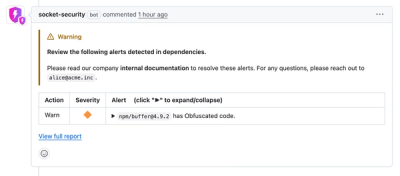
Security News
Crates.io Users Targeted by Phishing Emails
The Rust Security Response WG is warning of phishing emails from rustfoundation.dev targeting crates.io users.
@rhcp/sync-service
Advanced tools
REST API for deploying SPAs to the SPAship platform.
npm install -g @spaship/sync-service
spaship-sync-service
git@github.com:spaship/sync-service.git
npm install
From here, you can npm start to launch the service, or npm run dev to launch the service with auto-restart when source files are changed.
This repo follows Conventional Commits, a standard format for writing commit messages. Each commit message becomes an entry in CHANGELOG.md, and the commit messages are also used to determine what version bump to apply.
Read more about Conventional Commits for a description and examples!
If you are working on a pull request, don't worry about commit message format. Commit early and often.
When your pull request is merged, "squash and merge" should be used, and a Conventional Commit message written at that point. In this way, your pull request will become a single commit in the master branch and one entry in the CHANGELOG will be created.
Configuration can be provided by CLI flags, environment variables, or a configuration file. Arguments are processed in that order, so CLI flags take precedence over environment variables, which take precedence over the configuration file.
| Option | Description | CLI | Env | config.json | Default |
|---|---|---|---|---|---|
| config file | Where to find the config file. | --config-file | SPASHIP_CONFIG_FILE | N/A | stuff |
| upload dir | Directory to upload SPA archives. | --upload-dir | SPASHIP_UPLOAD_DIR | "upload_dir" | /tmp/spaship_uploads |
| webroot | Directory to extract/deploy SPAs. | --webroot | SPASHIP_WEBROOT | "webroot" | /var/www |
| host | Hostname to run on. | --host | SPASHIP_HOST | "host" | localhost |
| port | Port to run on. | --port | SPASHIP_PORT | "port" | 8008 |
Note about the filepath configurations, config file, upload dir, and webroot: they must be absolute paths when defined in an environment variable or config file. When defined in CLI options like, they can be written relative to CWD. Example: --config-file=./config.json
Each deployed SPA gets a hidden directory inside webroot which houses two files that contain some SPA metadata, ref and name.
For example, a SPA deployed with name "My App", path /my-app, and ref v1.0.0 would result in a webroot that looks like this:
www
├── .my-app
│ ├── name
│ └── ref
└── my-app
└── index.html
Deploy a SPA to SPAship. A very simple Web UI is provided, or the deployment can be automated with an HTTP request.
NAME="My Awesome Application"
SPA_PATH="/my-app"
REF="v1.0.0"
curl -v -F upload=@test.zip -F name="$NAME" -F path="$SPA_PATH" -F ref="$REF" localhost:8008/deploy
Change localhost:8008 to the host and port the service is running on. Change APP_NAME to your preferred app name, and test.zip to the archive you want to upload.
When you run the deployment service, it will print something like:
Listening on http://localhost:8008
Open that URL in a browser and you'll see a form for uploading apps.
Returns a list of all deployed SPAs. If they have a metadata directory, that metadata will be included.
Here's an example response from /list. Two apps are listed in the example, "SPAnom" has metadata and "SPAnonymous" does not.
[
{
"name": "SPAnominal",
"path": "/spanominal",
"ref": "v1.0.0"
},
{
"name": null,
"path": "/spanonymous",
"ref": null
}
]
A few notes about the response.
path is not stored in the metadata directory; it's inferred from the SPA's directory in the webroot.null values for name and ref because it was not deployed with /deploy, but it's included so that /list provides a complete report of what paths are being made available.FAQs
The file synchronization service for the SPAship platform.
We found that @rhcp/sync-service demonstrated a not healthy version release cadence and project activity because the last version was released a year ago. It has 4 open source maintainers collaborating on the project.
Did you know?

Socket for GitHub automatically highlights issues in each pull request and monitors the health of all your open source dependencies. Discover the contents of your packages and block harmful activity before you install or update your dependencies.

Security News
The Rust Security Response WG is warning of phishing emails from rustfoundation.dev targeting crates.io users.

Product
Socket now lets you customize pull request alert headers, helping security teams share clear guidance right in PRs to speed reviews and reduce back-and-forth.

Product
Socket's Rust support is moving to Beta: all users can scan Cargo projects and generate SBOMs, including Cargo.toml-only crates, with Rust-aware supply chain checks.